| This article may require cleanup to meet Misplaced Pages's quality standards. No cleanup reason has been specified. Please help improve this article if you can. (June 2011) (Learn how and when to remove this message) |
| Luzhou 泸州市 | |
|---|---|
| Prefecture-level city | |
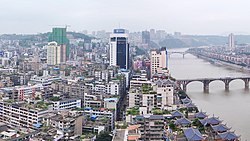 Luzhou in 2008 Luzhou in 2008 | |
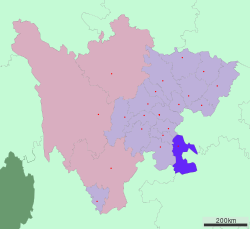 Location of Luzhou City jurisdiction in Sichuan Location of Luzhou City jurisdiction in Sichuan | |
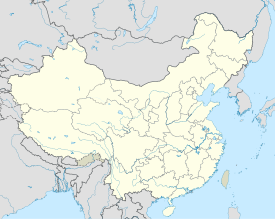 | |
| Coordinates (Luzhou municipal government): 28°52′16″N 105°26′31″E / 28.871°N 105.442°E / 28.871; 105.442 | |
| Country | People's Republic of China |
| Province | Sichuan |
| County-level divisions | 7 |
| Established | 151 BC |
| Municipal seat | Jiangyang District |
| Government | |
| • Type | Prefecture-level city |
| • CPC Luzhou Secretary | Jiang Fuyi (蒋辅义) |
| • Mayor | Liu Qiang (刘强) |
| Area | |
| • Prefecture-level city | 12,233.58 km (4,723.41 sq mi) |
| • Metro | 981.7 km (379.0 sq mi) |
| Elevation | 262 m (860 ft) |
| Population | |
| • Prefecture-level city | 4,254,149 |
| • Density | 350/km (900/sq mi) |
| • Urban | 1,596,119 |
| • Metro | 1,241,273 |
| • Metro density | 1,300/km (3,300/sq mi) |
| Demonym | Luzhouese |
| Major ethnic groups | |
| • Han | 98.47% |
| • Hmong | 1.26% |
| • other ethnic groups | 0.27% |
| GDP | |
| • Per capita | CN¥ 65,662 US$ 9,291 |
| Time zone | UTC+8 (China Standard) |
| Postal code | 646000 |
| Area code | 830 |
| ISO 3166 code | CN-SC-05 |
| City flower | Osmanthus fragrans |
| City tree | Longan tree |
| Regional dialect | Chuan: Luzhou dialect (泸州话) |
| License plate prefix | 川E |
| Website | luzhou |
Luzhou (simplified Chinese: 泸州; traditional Chinese: 瀘州; pinyin: Lúzhōu; Sichuanese Pinyin: Nuzou; Luzhou dialect: [nu˨˩tsəu˥]), formerly transliterated as Lu-chou or Luchow, is a prefecture-level city located in the southeast of Sichuan Province, China. It is also known as the "Liquor City" (酒城). It was named Jiangyang (simplified Chinese: 江阳; traditional Chinese: 江陽; pinyin: Jiāngyáng) until the Northern and Southern dynasties. Situated at the confluence of the Tuo River and the Yangtze River, Luzhou has been Sichuan province's largest port in both size and output since Chongqing's separation from Sichuan in 1997. As of the 2020 Chinese census, its population was 4,254,149. Of these, 1,241,273 lived in the built-up (or metro) area made of Jiangyang and Longmatan districts, as Naxi district is not conurbated yet. Luzhou borders Yunnan, Guizhou provinces and the Chongqing municipality. As the only geographic junction of the four provinces, it was an important port location in ancient China. After the PRC was founded in 1949, Luzhou became the capital of southern Sichuan province. In 1983, Luzhou was upgraded to prefecture-level city status.
Luzhou is best known for its alcoholic beverages, particularly baijiu.
History
Luzhou was incorporated into the Ba state early in the Shang and Zhou period, in the 11th century BC. In 316 BC, during the Warring States period, King Huiwen of Qin established Ba prefecture, which included most of Luzhou, after he conquered the states of Ba and Shu. The local economy and culture expanded as a result of the advanced production technique and culture introduced by immigrants from the rest of China. During the Western Han dynasty (206 BC-AD 9), Jiangyang county was set up in what is the current Jiangyang district, at the confluence of the Tuo River and Yangtze River. The county was further expanded during the reign of Emperor Wu of Han. As a result, Luzhou became the portal of the Tuojing River leading to western Sichuan, which brought great prosperity to salt-refinery and agriculture in the area.
The Song dynasty was an important period in Luzhou's history. It was known as the natural granary of southern Sichuan as the liquor-distilling and salt-refining industries expanded. The method to decoct salt with natural gas was discovered at that time, according to ancient literature. In addition, trade and business between Luzhou residents and ethnic groups was brisk and a protective wall as well as forts were constructed by the local government.
In the Yuan dynasty, Luzhou remained an important place for trade, especially the liquor-distillation, salt-refinery and tea-making industries. A large number of wooden ships were constructed to further the shipping industry.
During the Qing dynasty (1644–1911), waves of immigrants from other parts of China brought rapid growth in economy and culture. Luzhou served as a political, economic, military and cultural center for the provinces of Sichuan, Guizhou and Yunnan.
On December 6, 1949, two months after the founding of the People's Republic of China, the People's Liberation Army took control of Luzhou from the Kuomintang government. In 1960, Luzhou prefecture was created with five counties that had been part of Yibin prefecture. The prefecture was upgraded to the prefecture-level city of Luzhou in 1983. Nowadays, Luzhou is considered a center of the chemical, machinery, and liquor-distilling industries.
Historic and cultural relics

Bao’en Pagoda
Located in downtown Luzhou, the Bao’en Pagoda (simplified Chinese: 报恩塔; traditional Chinese: 報恩塔; pinyin: bào'ēn tǎ) was built in 1148 at the request of southern Song dynasty, and was restored in 1983 and 1985, Qing dynasty. It is an octagon 33.3 m high, built of brick and stone in a seven-tiered pavilion style. It has a bronze top and there are 107 steps in its spiral staircase. The base is an octagon of 4.1 m per side, 4.5 m high; inside are 256 figures set in 90 niches. The pagoda was listed by the People's Government of Sichuan Province as a historical and cultural relic under provincial protection in April 1991.
Dragon Head Bridge
Constructed during the Ming dynasty, Dragon Head Bridge spans the Nine Bends Creek and is a stone bridge in the Ming dynasty style. It is 5 m high, 54 m long and 1.9 m wide, and has 14 piers. The eight midsection piers are characterized by traditionally carved auspicious beasts, such as dragons, lions, elephants and qilin. It was declared a key national cultural relic in 1996.
Longtou Pass
Longtou Pass, about 2.5 km (1.6 mi) long, is located in the southern suburban area of Luzhou. Construction began in the Han dynasty during the Guangxu Emperor's reign. Its name, Longtou Pass, derives from its resemblance to a huge dragon crossing the Tuo River in the north and Yangtze river in the south. Longtou Pass is the location where Liu Bocheng waged the Luzhou Uprising. It was listed as a protected historic and cultural relic of Luzhou in 1984 and a provincial one in 1996.
Guojiao Square
The Guojiao Square (simplified Chinese: 国窖广场; traditional Chinese: 國窖廣場; pinyin: Guójiào guángchǎng; lit. 'National Fermentation Pit Square') is a key cultural site of baijiu producer Luzhou Laojiao. Its name refers to a baijiu fermentation pit that was commissioned during the Ming dynasty in 1573 and has been in continuous operation ever since. The square is an AAAA-level scenic spot, listed under the name Luzhou Laojiao Tourism Area (simplified Chinese: 泸州老窖旅游区; traditional Chinese: 瀘州老窖旅遊區; pinyin: Lúzhōu Lǎojiào lǚyóu qū).
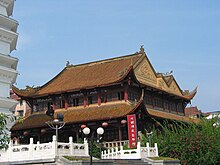
Spring and Autumn Temple
Situated in Xuyong county, the Spring and Autumn Temple was built in 1906, during the Qing dynasty. Originally, it was a temple for Guany (the Lord of Guan) and then rebuilt as a Shaanxi salt merchants' assembly hall. It has a typical local architecture style, and has been listed as a protected historic and cultural relic of Luzhou.
Baizitu
Baizitu is situated near the Tuojiang river, in the northwestern corner of Luzhou city. It is named for the stone inscription of the Qing dynasty and was the protected historic and cultural relic of Luzhou.
Luzhou City Park
Built in 2015, Luzhou City Park is an important project of Luzhou City in order to promote the ecological environment construction, and upgrade the eco-city level of Luzhou City. The total investment of the project is about 120 million RMB and covers an area of about 107 mu. It is located in the valley of the east of Chengxi Park in Jiangyang, Luzhou. Superior, is expected to receive more than 1.5 million tourists trips each year.
Administrative divisions
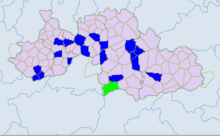
| Map | ||||||
|---|---|---|---|---|---|---|
 Jiangyang
Naxi
Longmatan
Lu
Jiangyang
Naxi
Longmatan
LuCounty Hejiang County Xuyong County Gulin County | ||||||
| # | Name | Hanzi | Hanyu Pinyin | Population (12 31 2017 est.) | Area (km) | Density (/km) |
| 1 | Jiangyang District | 江阳区 | Jiāngyáng Qū | 616,500 | 649 | 950 |
| 2 | Naxi District | 纳溪区 | Nàxī Qū | 488,300 | 1,151 | 407 |
| 3 | Longmatan District | 龙马潭区 | Lóngmǎtán Qū | 382,400 | 333 | 1150 |
| 4 | Lu County | 泸县 | Lú Xiàn | 870,100 | 1,532 | 568 |
| 5 | Hejiang County | 合江县 | Héjiāng Xiàn | 707,600 | 2,422 | 292 |
| 6 | Xuyong County | 叙永县 | Xùyǒng Xiàn | 581,600 | 2,975 | 195 |
| 7 | Gulin County | 古蔺县 | Gǔlìn Xiàn | 690,700 | 3,172 | 218 |
Geography

Luzhou is situated in the southeast region of Sichuan province, at the intersection of Sichuan, Yunnan, Guizhou and Chongqing, at longitude 105° 08' 41"E ~ 106° 28'E and latitude 27° 39' N ~ 29° 20'N. Covering an area of 12,246.87 square kilometres (4,728.54 sq mi), it is 121.64 kilometres (75.58 mi) wide from east to west and 181.84 kilometres (112.99 mi) long from south to north. A prefecture-level city of Sichuan with a registered population of 4.8 million, Luzhou is 267 km (166 mi) away from Chengdu, the provincial capital. It is adjacent to Chongqing in the east, borders Guizhou and Yunnan provinces in the south, Yibin City and Zizhong City in the west, Chongqing and Neijiang in the north. The city governs 7 administrative divisions, including 3 districts (Jiangyang, Longmatan, Naxi) and 4 counties (Lu, Hejiang, Xuyong, Gulin).
Owing to its position in the southern peripheral area of Sichuan Basin and the connective region with Yunnan and Guizhou plateau, Luzhou is characterised by river valleys, hills, and level lands in the north and highland areas, and by mountains, sheer valleys, and rushing rivers in the south. Fishing and agriculture are the primary industries in the northern area, and forest and mineral resources are primary in the southern part of the region. Luzhou's lowest point is 203 metres (666 ft), at the surface of Yangtze river in Jiucengyan, Hejiang county, while the highest point is located at the peak of Liangzi mountain, Xuyong County, reaching 1,902 metres (6,240 ft). Luzhou is also a region covered by rivers. The Yangtze river flows through the whole area from west to east, covering a total course of 133 kilometres (83 mi), and the maximum flood level was 18.68 metres (61.3 ft) during the past 30 years. Other rivers converge here, such as Tuo River, Yongling River, Chishui River, and Laixi River.
Climate

Luzhou has a monsoon-influenced humid subtropical climate (Köppen Cfa) and is largely mild, except during the summer, and humid, with four distinct seasons and ample rainfall: winters are short, mild, and comparatively dry, while summers are long, hot, and humid. Within the prefecture, annual mean temperatures range from 17.1 to 18.5 °C (62.8 to 65.3 °F). In the urban area, monthly daily average temperatures range from 7.6 °C (45.7 °F) in January to around 27 °C (80.6 °F) in July and August, with August being slightly warmer. The diurnal temperature variation is 6.1 °C (11.0 °F) and is lowest during winter. Snow is rare here. The annual precipitation in the prefecture ranges from 748.4 to 1,184.2 millimetres (29.46 to 46.62 in), 70% of which occurs from May to September. Sunshine is quite low, with only 1200 to 1400 hours per year, and the frost-free period is lengthy, lasting 300 to 358 days.
| Climate data for Luzhou (Naxi District), elevation 367 m (1,204 ft), (1991–2020 normals, extremes 1971–2000) | |||||||||||||
|---|---|---|---|---|---|---|---|---|---|---|---|---|---|
| Month | Jan | Feb | Mar | Apr | May | Jun | Jul | Aug | Sep | Oct | Nov | Dec | Year |
| Record high °C (°F) | 17.2 (63.0) |
23.2 (73.8) |
32.5 (90.5) |
35.1 (95.2) |
37.5 (99.5) |
37.6 (99.7) |
38.1 (100.6) |
39.7 (103.5) |
39.8 (103.6) |
31.5 (88.7) |
26.9 (80.4) |
18.8 (65.8) |
39.8 (103.6) |
| Mean daily maximum °C (°F) | 9.9 (49.8) |
13.0 (55.4) |
18.0 (64.4) |
23.5 (74.3) |
26.7 (80.1) |
28.5 (83.3) |
31.9 (89.4) |
32.1 (89.8) |
27.0 (80.6) |
21.0 (69.8) |
16.7 (62.1) |
11.1 (52.0) |
21.6 (70.9) |
| Daily mean °C (°F) | 7.5 (45.5) |
9.9 (49.8) |
14.0 (57.2) |
18.8 (65.8) |
22.0 (71.6) |
24.2 (75.6) |
27.0 (80.6) |
27.0 (80.6) |
22.9 (73.2) |
18.0 (64.4) |
13.8 (56.8) |
8.8 (47.8) |
17.8 (64.1) |
| Mean daily minimum °C (°F) | 5.7 (42.3) |
7.7 (45.9) |
11.1 (52.0) |
15.3 (59.5) |
18.5 (65.3) |
21.2 (70.2) |
23.5 (74.3) |
23.3 (73.9) |
20.2 (68.4) |
16.0 (60.8) |
11.7 (53.1) |
7.2 (45.0) |
15.1 (59.2) |
| Record low °C (°F) | −1.1 (30.0) |
−0.7 (30.7) |
1.8 (35.2) |
5.8 (42.4) |
10.5 (50.9) |
15.3 (59.5) |
17.6 (63.7) |
17.6 (63.7) |
14.1 (57.4) |
6.3 (43.3) |
2.6 (36.7) |
−1.9 (28.6) |
−1.9 (28.6) |
| Average precipitation mm (inches) | 32.2 (1.27) |
26.8 (1.06) |
50.1 (1.97) |
85.2 (3.35) |
122.1 (4.81) |
193.0 (7.60) |
166.2 (6.54) |
156.9 (6.18) |
132.9 (5.23) |
93.5 (3.68) |
45.8 (1.80) |
32.2 (1.27) |
1,136.9 (44.76) |
| Average precipitation days (≥ 0.1 mm) | 13.5 | 11.2 | 12.9 | 14.0 | 15.8 | 17.5 | 13.4 | 11.9 | 14.9 | 18.2 | 13.2 | 13.4 | 169.9 |
| Average snowy days | 0.3 | 0.1 | 0 | 0 | 0 | 0 | 0 | 0 | 0 | 0 | 0 | 0.2 | 0.6 |
| Average relative humidity (%) | 87 | 83 | 79 | 78 | 79 | 85 | 81 | 79 | 84 | 89 | 87 | 88 | 83 |
| Mean monthly sunshine hours | 32.3 | 52.7 | 94.4 | 123.7 | 127.3 | 110.5 | 184.6 | 186.1 | 103.4 | 52.3 | 50.6 | 29.6 | 1,147.5 |
| Percent possible sunshine | 10 | 17 | 25 | 32 | 30 | 26 | 43 | 46 | 28 | 15 | 16 | 9 | 25 |
| Source 1: China Meteorological Administration | |||||||||||||
| Source 2: Weather China | |||||||||||||
Economy
Luzhou has always been a hub of economic activities in the tri-province border area of Sichuan, Yunnan, and Guizhou. Food, liquor, and chemicals production, along with construction equipment manufacturing are the most important industries of the local economy. In 2006, Luzhou's total GDP reached 33.11 billion yuan (7,819 yuan per capita).
Liquor industry
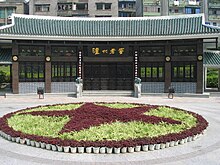
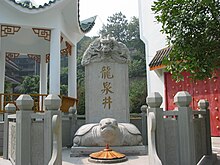
Luzhou is a center of liquor production, particularly baijiu. Luzhou Laojiao (Chinese: 泸州老窖; lit. 'Luzhou Old Fermentation Pit') and Gulin Langjiu (Chinese: 古蔺郎酒) are the two best known brands with national and international reputation.
Machine construction industry
Luzhou is a manufacturing center of hydraulic trucks, cranes and excavators in China. Among the cities along the Yangtze River, Luzhou is the second largest producer of hydraulic trucks, after Shanghai.
Chemical industry
The chemical industry, particularly natural gas production, is also important to Luzhou's economy. At present, Luzhou has developed a national chemical industry system covering production, education, scientific research, design, machine and architecture. A group of national large scale enterprises have been established and achieved a globally advanced level. Lutianhua enterprise is the most extensive carbamide and oil chemical production base in China, producing fatty acid, fatty amine, synthetic ammonia, and carbamide. Its annual output of carbamide is 1.24 million tons and 0.9 million tons of synthetic ammonia. It is one of the 500 largest national enterprises. Tianhua Co, Ltd is a key enterprise which brings in 0.3 million tons of synthetic ammonia and 0.6 million tons of carbamide, processing two sets of chemical fertilizer devices with world technical levels. Luzhou Chemical Factory participates in military and civil chemical production. State-owned Torch Chemical Factory is the only producer of "801" . It gained the national quality golden award, surpassing the America Standard.
Tourism industry

Luzhou is a tourist destination; specific scenic spots include Yuchan in Luxian county, Fobao in Hejiang county, Mt. Fangshan in Jiangyang county, the lychee and longan orchard along the Yangtze River and Tuojiang River, and many others. With the official approbation of the National Ministry of Forestry, Fobao Forest Park became a National Forestry Park and was classified as an “AAA” tourist attraction in 2001 by the National Tourism Administration.
Luzhou and Xuyong county have national cultural significance. The Luzhou Old Fermentation Pit (Luzhou Laojiao, 泸州老窖) and Dragon Head Bridge are listed as key protected cultural relics of the nation. There are more than ten protected historical relics in Sichuan Province, including the site of the Battle of Chishui River. This site was chosen as the “National Demonstration Base for Patriotic Education” by the Central Propaganda Ministry in 2001.
The Sci-tech Park of Luzhou Laojiao is a national industry tourism demonstration spot and Luzhou Zhangba Longan Orchard is a national agricultural tourism spot. Other scenic areas nearby include Leshan, Yibin, Zigong and Chongqing, such as the Bamboo Forest, Mt. Simianshan in Chongqing and Sidong Channel in Guizhou Province.
Agriculture
Luzhou is a key comprehensive development zone in the upper Yangtze River and Sichuan province as well as an important production base for rice, fruit such as litchi and longan, cured tobacco, poultry, tea, and traditional Chinese medicine ingredients.
Free Trade Zone
The Sichuan Pilot Free Trade Zone (FTZ) officially launched on 1 April 2017, forms part of a third batch of government-endorsed pilot FTZs. All told, the zone covers an area of 119.99 km and consists of three sub-zones: The Chengdu Tianfu New Area (90.32 km inclusive of the Chengdu High-Tech Comprehensive Bonded Area 4 (Shuangliu Park) (4 km) and the Chengdu Airport Bonded Logistics Centre (Type B) (0.09 km)), the Chengdu Qingbaijiang Railway Port Area (9.68 km inclusive of the Chengdu Railway Bonded Logistics Centre (Type B) (0.18 km)), and the Chuannan Lingang Area (19.99 km inclusive of the Luzhou Port Bonded Logistics Centre (Type B) (0.21 km)).
The Chuannan Lingang Area will focus on developing a range of high quality professional services, including shipping logistics, port trade, education and medical support. As part of its remit, it will also look to nurture the advanced manufacturing industries, as well as looking to take a lead in a number of other sectors, including equipment manufacturing, medicine and food/beverages. Furthermore, it will play a key role in the development of an integrated transport hub, which will provide streamlined connections between the Chengdu-Chongqing city cluster and Yunnan and Guizhou, its southerly neighbours.
Transport

Expressways connecting to Chengdu and Chongqing were completed in the 1990s. Railroads and an airport provide additional links to several cities in China. The city has four bridges over the Yangtze which form part of Sichuan's overland corridor to the South China Sea.
Road
The G76 Xiamen-Chengdu Expressway connects Luzhou to Chengdu and Guiyang, the G93 Chengdu Ring Expressway connects Luzhou to Chongqing, and the G4215 Chengdu-Zunyi Expressway connects Luzhou to Chengdu and Zunyi. Other main highways include G321, G353 Heze-Baoji, the national highway and several provincial highways.
Rail
Luzhou is served by a freight-only branch. A passenger service briefly operated but was cancelled in 1995. A new railway station served by multiple high-speed lines has opened on June 28, 2021, with links to Chengdu and various other cities.
Luzhou Port
Luzhou is an important inland port serving as a transshipment point for goods heading to cities deeper into Sichuan such as Chengdu. Making it the largest river port in Sichuan on the upper Yangtze, with the capability to load and unload container ships. The Luzhou International Container Pier handled over 500,000 containers in 2016.
Luzhou Airport
Luzhou Lantian Airport was built in 1945 and initially provided an air route between China and India for the US Air Force during World War II. Services were suspended in the 1960s, but later it was used for training purposes by the Chinese Air Force. Major renovations and expansions were completed in January 2001, and now the airport serves direct flights to Beijing, Shanghai, Guangzhou, Kunming, Guiyang, Shenzhen, Xiamen, Hangzhou, Haikou, Changsha, Nanning, Xi'an, Daocheng Yading Airport, Lanzhou, Lijiang, Nanjing, Wuhan and Zhengzhou. The new Luzhou Yunlong Airport opened in September 2018, and all services were transferred from Lantian to the new location, 11 km north of the city.
Education
- Southwest Medical University (西南医科大学)
- Sichuan Police College (四川警察学院)
- Luzhou Vocational and Technical College] (泸州职业技术学院)
- Sichuan Vocational College of Chemical Technology (四川化工职业技术学院)
- Sichuan Sanhe College of Professionals (四川三河职业技术学院)
Notable people
| This article's list of people may not follow Misplaced Pages's verifiability policy. Please improve this article by removing names that do not have independent reliable sources showing they merit inclusion in this article AND are members of this list, or by incorporating the relevant publications into the body of the article through appropriate citations. (May 2022) |
- Gu Yi- student dissident and human rights activist
- Wan Shenzi- Qing-era couplet writer
- Yin Jifu- minister to King Xuan of Zhou
- Zou Kai- artistic gymnast
References
- "China: Sìchuān (Prefectures, Cities, Districts and Counties) - Population Statistics, Charts and Map".
- zh:苗族蒙人
- 四川省统计局、国家统计局四川调查总队 (2016). 《四川统计年鉴-2016》. 中国统计出版社. ISBN 978-7-5037-7871-1.
- |demographics2_info1 = CN¥ 272.5 billion
US$ 38.4 billion - "The Liquor from Luzhou".
- "四川省文化和旅游厅" (in Chinese). 2024-03-14. 4A级旅游景区 #39. Archived from the original on 2024-03-14. Retrieved 2024-03-14.
- 中国气象数据网 – WeatherBk Data (in Simplified Chinese). China Meteorological Administration. Retrieved 17 September 2023.
- 中国气象数据网 (in Simplified Chinese). China Meteorological Administration. Retrieved 17 September 2023.
- 泸州 - 气象数据 -中国天气网 (in Simplified Chinese). Weather China. Retrieved 21 November 2022.
- "Home". sclth.com.
- 谢, 佳君 (28 January 2010). "成都到泸州 坐火车有谱了!". Chengdu Commercial Daily. Retrieved 8 October 2020.
- Luzhou International Container Pier
- "CCTV-English Channel-Rediscovering China".
- Sichuan Police College
- Luzhou Vocational and Technical College
- Sichuan Vocational College of Chemical Technology
- Sichuan Sanhe College of Professionals



